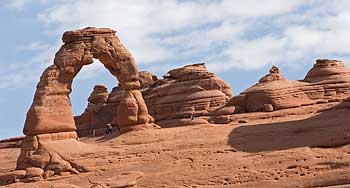Arches National Park
Arches National Monument was established by Presidential Proclamation on April 12, 1929. The proclamation states that the monument was established "to protect extraordinary examples of wind erosion in the form of giganticarches, natural bridges, 'windows,' spires, balanced rocks and other unique wind-worn sandstone formations, the preservation of which is desirable because of their education and scenic value."Arches National Park preserves over 2,000 natural sandstone arches, like the world-famous Delicate Arch, and Landscape Arch, as well as many other unusual rock formations. The park contains the greatest density of natural arches in the world formed through the forces of nature acting in concert to create the landscape of Arches. Throughout the park, rock layers reveal millions of years of deposition, erosion and other geologic events. These layers continue to shape life in Arches today, as their erosion influences elemental features like soil chemistry and where water flows when it rains. The extraordinary features of the park create a landscape of contrasting colors, landforms and textures that is unlike any other in the world.
Arches is located in a "high desert," with elevations ranging from 4,085 to 5,653 feet above sea level. The climate is one of very hot summers, cold winters and very little rainfall. Even on a daily basis, temperatures may fluctuate as much as 50 degrees.
The plants and animals in Arches have many adaptations that enable them to survive these conditions. Some species are found only in this area. The diversity of organisms reflects the variety of available habitat, which includes lush riparian areas, ephemeral pools, dry arroyos, mixed grasslands and large expanses of bare rock.
Park Facts
- Park Designations:
Arches National Monument - April 12, 1929
Arches National Park - November 12, 1971 - Acreage: 76,519 acres or 119 square miles
- Highest Elevation: Elephant Butte 5,653 feet
- Lowest Elevation: Visitor Center 4,085 feet
- Average annual precipitation: 10 inches
- Number of documented arches: 2,000 and counting
- Largest arch: Landscape Arch (over 300 feet)
- Visitation: 769,672 (in the year 2002)
- 483 species of plants
Rare species: Canyonlands Biscuitroot - 186 species of birds
Threatened species: Bald Eagle, Mexican Spotted Owl
Endangered species: (De-listed in 2001) Southwestern Willow Flycatcher - 52 species of mammals
- 6 species of fish
Endangered species: Bonytail Chub, Colorado Pikeminnow, Humpback Chub, Razorback Sucker - 6 species of amphibians
- 21 species of reptiles
- Historic structure
- Wolfe Cabin
